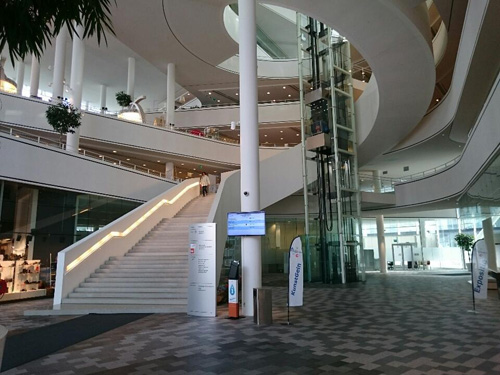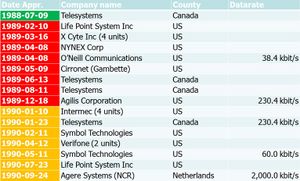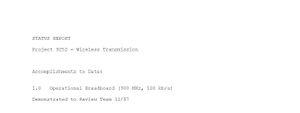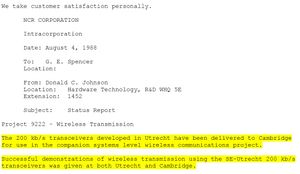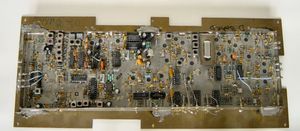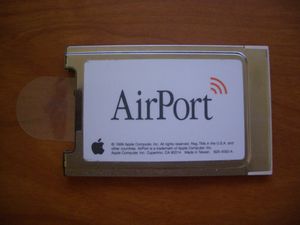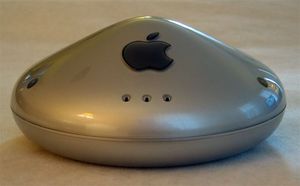Milestone-Proposal:The birth of WiFi
To see comments, or add a comment to this discussion, click here.
Docket #:2015-13
This Proposal has been approved, and is now a Milestone
To the proposer’s knowledge, is this achievement subject to litigation? No
Is the achievement you are proposing more than 25 years old? Yes
Is the achievement you are proposing within IEEE’s designated fields as defined by IEEE Bylaw I-104.11, namely: Engineering, Computer Sciences and Information Technology, Physical Sciences, Biological and Medical Sciences, Mathematics, Technical Communications, Education, Management, and Law and Policy. Yes
Did the achievement provide a meaningful benefit for humanity? Yes
Was it of at least regional importance? Yes
Has an IEEE Organizational Unit agreed to pay for the milestone plaque(s)? Yes
Has the IEEE Section(s) in which the plaque(s) will be located agreed to arrange the dedication ceremony? Yes
Has the IEEE Section in which the milestone is located agreed to take responsibility for the plaque after it is dedicated? Yes
Has the owner of the site agreed to have it designated as an IEEE Milestone? Yes
Year or range of years in which the achievement occurred:
1987
Title of the proposed milestone:
WaveLAN, Precursor of Wi-Fi, 1987
Plaque citation summarizing the achievement and its significance; if personal name(s) are included, such name(s) must follow the achievement itself in the citation wording: Text absolutely limited by plaque dimensions to 70 words; 60 is preferable for aesthetic reasons.
In November 1987, a group of Dutch engineers in Nieuwegein demonstrated a method for significantly increasing the data rate achievable under new regulations that permitted license-exempt short-range wireless data communications in certain frequency bands. Their development of WaveLAN technology led directly to formation of the IEEE 802.11 Working Group for Wireless Local Area Networks and establishment of the now ubiquitous Wi-Fi industry.
200-250 word abstract describing the significance of the technical achievement being proposed, the person(s) involved, historical context, humanitarian and social impact, as well as any possible controversies the advocate might need to review.
IEEE technical societies and technical councils within whose fields of interest the Milestone proposal resides.
In what IEEE section(s) does it reside?
IEEE Benelux Section
IEEE Organizational Unit(s) which have agreed to sponsor the Milestone:
IEEE Organizational Unit(s) paying for milestone plaque(s):
Unit: IEEE Benelux Section
Senior Officer Name: Bart Smolders, chairman
IEEE Organizational Unit(s) arranging the dedication ceremony:
Unit: IEEE Benelux Section
Senior Officer Name: Bart Smolders, chairman
IEEE section(s) monitoring the plaque(s):
IEEE Section: IEEE Benelux Section
IEEE Section Chair name: Bart Smolders, chairman
Milestone proposer(s):
Proposer name: Wim van Etten
Proposer email: Proposer's email masked to public
Please note: your email address and contact information will be masked on the website for privacy reasons. Only IEEE History Center Staff will be able to view the email address.
Street address(es) and GPS coordinates in decimal form of the intended milestone plaque site(s):
Stadsplein 1, 3431 LZ, Nieuwegein GPS coordinates: x 134.280 y 488.890
Describe briefly the intended site(s) of the milestone plaque(s). The intended site(s) must have a direct connection with the achievement (e.g. where developed, invented, tested, demonstrated, installed, or operated, etc.). A museum where a device or example of the technology is displayed, or the university where the inventor studied, are not, in themselves, sufficient connection for a milestone plaque.
Please give the details of the mounting, i.e. on the outside of the building, in the ground floor entrance hall, on a plinth on the grounds, etc. If visitors to the plaque site will need to go through security, or make an appointment, please give the contact information visitors will need. The intended site is a building where various organizations are housed (municipality of Nieuwegein, a library, social service and social welfare). Therefore it is called ‘Stadshuis’ (= city house). It is the closest public accessible building from where Wi-Fi was originally developed (an office building at a distance of approximately 600 m).
Are the original buildings extant?
The original buildings where the development took place now serve a different goal, are no longer publicly accessible, and will probably be demolished within a few years.
Details of the plaque mounting:
The intended location is in the central entrance hall of the building. A picture giving an overview of the entrance hall of the town hall is shown below. The IEEE can consult the municipality of Nieuwegein about the exact place and mounting within the hall.
How is the site protected/secured, and in what ways is it accessible to the public?
The building is opened on weekdays and Saturdays. The site is protected/secured by a security company and security cameras.
Who is the present owner of the site(s)?
Municipality of Nieuwegein
What is the historical significance of the work (its technological, scientific, or social importance)? If personal names are included in citation, include detailed support at the end of this section preceded by "Justification for Inclusion of Name(s)". (see section 6 of Milestone Guidelines)
In essence, WaveLAN technology has brought wireless networking at high data rates. The technology used Direct Sequence Spread Spectrum modulation within the regulatory rules, about 10 times higher than was the state of the art (see Figure 1) and an access system to the radio medium through a known control system with an added feature that provided efficiency in the use in the local area. The WaveLAN technology is still applied in all handheld devices, from laptops to tablets, printers and mobile phones. Socially and economically it provides fast and efficient, wireless, connection to the Internet at businesses, hotels, stations, restaurants, shops, public buildings, residences, in trains and even in airplanes etc. It is very easy to deploy such networks within a meeting room and connect all attendees to the Internet or local servers to disseminate meeting documentation. This technology brings ease of access to information supporting both the workforce as well as the crowd seeking entertainment. WaveLAN overcame many hurdles that enabled Wi-Fi later on.
What obstacles (technical, political, geographic) needed to be overcome?
Wireless data transfer rate too low
Early in the investigation of the technology, it was understood that a transparent user experience was required. At that time, office and business communication systems using wired Local Area Network technology carried data rates exceeding 1 megabit per second. No commercial wireless technology was available that approached that speed barrier. To reach that goal, sufficient radio bandwidth was needed that was easily accessible. In 1985 the spectrum regulator for non-federal users in the US, the Federal Communications Commission (FCC), permitted the use for communications, in three bands, without requiring an end-user license for the use of a radio transmitter (ease of access), provided the radio used “spread spectrum”. With spread spectrum, the data is transmitted over a larger amount of bandwidth than needed, either by multiplying the data with a pseudo-random codei (dubbed direct sequence spread spectrum), or by changing the centre frequency in a pseudo random pattern (dubbed frequency hopping spread spectrum). The spectrum was provided at frequencies close to or above 1 GHz. The characteristics of the radio waves at that frequency in general, but especially its indoor characteristics, were unknown. Propagation measurements needed to be done. Silicon circuitsii were only available in commercially viable prices for the lowest of the three bandsiii so that was the band to use in the 1985-1995 timeframe. Unfortunately only 26 MHz of spectrum was available. Frequency hopping could only use a bandwidth of 25 kHz, limiting the maximum data rates to 25 kilobit per second. Direct sequence had no upper bandwidth limit, but the band itself limited the bandwidth to 26 MHz. However, the spreading requirement lowered the maximum bitrate proportionally because the transmitted data is to be multiplied by a pseudo-random code. The elements of the code are called chips. The FCC did not state a minimum number of chips. The general feeling was that 125 or 255 chips was required. The first experiments were implemented with Surface Acoustic Wave (SAW) Filters developed with the University of Delft [1]. However, even with a 100 chip pseudo-random code the 230 kilobit per second transfer rate was not sufficient for the application on hand. An eleven chip pseudo-random code, a so called Barker sequence, with superior properties was available. The question was, however, whether the FCC would permit pseudo-random code of 11 chips. A visit to the offices of the FCC taught that a 10 chips was the minimumiv. With the knowledge that the FCC would approve the length, the code was adopted and a 2 megabit per second data rate was achieved. This led to approval by the FCC for devices supporting a maximum data transfer rate of 2 megabit per second. As shown in Figure 1v, it was a nearly 10-fold increase over other products and it was applied in the WaveLAN product (Figure 2) released in 1990 (see Chapter “References to establish dates etc.”). Rather than using SAW filters, production units used Digital Signal Processing (DSP) chips.
Radio environment is difficult to control
In a license-exempt radio band, the users have to share the frequencies, both among similar devices as well as to devices using different protocols. To orderly use and share the radio channel a method of listen-before-talk is used, called carrier sense multiple access (CSMA). Before a station transmits it verifies at its receiver whether no other station is transmitting. There is a probability that two stations have established that the channel is free and start transmitting. In a cabled environment, the receiver of a transmitting station is able to detect such event. They both defer transmission by sending a jam signal to prevent stations to use the erred transmission. This method is called carrier sense multiple access with collision detection (CSMA/CD). In a radio environment, however, the signals attenuate quickly along the path they travel. In the wired medium, the attenuation is around 1000 times over 10 m, radio signals in free space at 2.4 GHz attenuate 10,000 times in the first meter, 1,000,000 in the first 11 meter. A transmitting wireless station cannot detect the signal of any other receiver because they are too weak. So neither transmitter sending at the same time can detect the collision and their transmissions are lost. To overcome subsequent collisions, stations that have detected a busy channel and defer transmission, have to wait a randomly selected back-off time after the channel becomes free, and decrement the back-off time while the channel is free. When the back-off time decrements to zero it will start its transmission. This way the waiting station for transmission with the smallest time set, starts transmission and other stations defer until the channel is free again and decrement the remainder of their back-off time while the channel is free again. This medium access protocol is called carrier sense multiple access with collision avoidance (CSMA/CA).
What features set this work apart from similar achievements?
WaveLAN achieved the highest data rate (2 Mbit/s, which was 10 times higher than competing systems at that time) using DSSS and 11 chip barker code (which was exact the same chip code used in the first IEEE 802.11 standard) and refined CSMA/CA protocol overlay (also same protocol framework used in 802.11). The implementation of higher “LAN” data rates and networking protocol incorporating a high level of data integrity (including Medium Access Layer Acknowledgement) enabled a “seamless integration” of Wireless LAN into the “Wired” 802 LAN infrastructure. In the 1990 to 1999 timeframe, cellular networks are based on voice connections with some data traffic at low transfer rates, use a centralised protocol in a large coverage area and use licensed spectrum. Usage is therefore costly because the service provider must pay for the, private, use of the spectrum in specific areas. To cover the area of up to 6 km2, the transmitters emit power up to 2 or 10 Watt. When more people want to use the network beyond its capacity, users are denied service (busy tone). WaveLAN technology is based on high speed connectivity with a distributed protocol in smaller geographic areas and using license-exempt spectrum. Because of the smaller geographic area used, the transmitters emit lower power (up to 50 mW) than transmitters in cellular networks. Hence the signals are only detectable within the smaller area and the spectrum can be reused in an adjacent geographic area. Voice connections can be made on top of the Internet protocol. Whereas cellular networks deny further service requests when the capacity is fully used, WaveLAN networks distribute the capacity among all users, so that users continue to be connected, though the transfer rate is reduced. The use of the spectrum is free of charge, the protocol is decentralised and can be used anywhere.
In summary, the work established a nearly 10 times higher data rate compared to the state of the art (Figure 1) for untethered data communication, with error detection at a level close to the medium, thus enabling quick recovery. Further, the work established a modified access protocol enabling networking at the local area as well as support for time-bounded services. Finally, the use of an existing chip, designed for other purposes, was devised to bring a product to market at reasonable price and within reasonable time.
Why was the achievement successful and impactful?
Supporting texts and citations to establish the dates, location, and importance of the achievement: Minimum of five (5), but as many as needed to support the milestone, such as patents, contemporary newspaper articles, journal articles, or chapters in scholarly books. 'Scholarly' is defined as peer-reviewed, with references, and published. You must supply the texts or excerpts themselves, not just the references. At least one of the references must be from a scholarly book or journal article. All supporting materials must be in English, or accompanied by an English translation.
The WaveLAN-team
The initiative leading to the development of wireless LAN products, the development of the IEEE 802.11 standard and the co-establishment of the Wi-Fi Alliance was taken at an Engineering Laboratory operating in Utrecht the Netherlands. In 1985 it was part of NCR Corporation. Further reference to the laboratory will be “WaveLAN-team”. Throughout its existence the WaveLAN-team operated under various corporate names. In 1991 NCR was acquired by AT&T, in 1996 AT&T split into three parts and the corporate name changed into Lucent Technologies. In 2001 Lucent Technologies sold some of their business units and the corporate name was changed into Agere Systems. Interesting to know is that Bell Labs collocated a department in the same building in 1994. Their charter was to do research in the same subjects as done by the WaveLAN-team. In the mid-nineteen eighties NCR, a US based company specialising in terminals for financial and retail institutions and small to mid-size computers, had the objectives to suit the wish of their retail customers to connect their terminals, cash registers, without cables to the back-office computer, so they did not need to drill new holes in their marble floors after changes in the floorplan. Experiments to connect through Infra-red links turned out to be tedious because the need to align transmitters and receivers and it limited the possibility of their customers to hang banners and other ornamentation in the shops. When the FCC permitted the use of spectrum without the need for an end-user license, NCR wanted to pursue this opportunity to resolve the cash register issue and assigned the request for an investigation into the feasibility of a radio link for retail terminals. They found the best skills to do an investigation at the WaveLAN-team. In addition to the engineers, the WaveLAN-team also operated with a team of product managers, responsible for the acquisition of funding, the marketing and the product lifecycle management. November 1987 the WaveLAN-team demonstrated the feasibility of a 100 kilobit per second radio link between two PCs to a review team of NCR Headquarters and people from the Retail Division of NCR, “customer” of the development work (Figure 3).
August 1988 the WaveLAN-team demonstrated a 200 kilobit per second prototype (Figure 4 and Figure 5). The cash registers were IBM compatible PC’s with special devices such as the display, the keyboard, the barcode reader and the receipt printer. The registers were not equipped with a hard disk. All information such as article name and price had to be communicated from the in-store processor. In the morning, when the cashiers started, the programs for all registers had to be uploaded from the in-store processor. Hence the need of data transfer rates of at least 1 megabit per second.
In search of a shorter than 125 chip code, one of the engineers at the WaveLAN-team used a small programmable calculator to investigate properties of shorter codes. When he entered a certain code of 11 chips, calculations showed that the properties were excellent. This is the code the FCC accepted. The WaveLAN-team decided to use the code for their developments. For the first release of the product, a simple and cost effective method was used by applying an off-the-shelf CSMA/CDvi controller chip. Many of the functions necessary to interact between the computer memory and the link were available in the chip. A patented method as described in US patent no 5,369,639 [2] is used to mimic the CSMA/CAvii control, yet using a CSMA/CD chip. The first public demonstration was given at Networld 90, Dallas (TX). It stirred the press [3]. Earlier in time, the WaveLAN-team was convinced that an industry standard for wireless communications among computers was important for acceptance by the users in the IT Industry. Hence the initiative to participate in a task group in the IEEE 802 project (Local and Metropolitan Networks Standards Committee) that already had a project approval for a wireless extension to the Token Bus Standards, IEEE 802.4. However, the members of the task group had already given up and the task group was inactive, so it was necessary to take the leadership in 1988. In 1989 the WaveLAN-team proposed the 11 chip pseudo-random code to the task group [4]. Mid 1990 the task group concluded that the IEEE 802.4 protocol was not suited to be used in a radio environment, hence in July 1990 they generated the paperwork to start a new Working Group for a Wireless Local Area Network. The establishment of the working group was approved by the members of working group 802.4 and was put on the floor of the IEEE 802 Executive Committee at their closing meeting of the plenary meeting. Following their approval, the first meeting was held in September 1990, chaired by an employee of the WaveLAN-team. Recognising that the resulting standards are made as result of group decisions, the WaveLAN-team provided the leadership. First by providing the chairman, and subsequently the technology both in submissions as well as know-how stemming from its experience with its product. The WaveLAN team brought the first known radio with 2 Mbit/s data rates to the market. The direct sequence modem technology as used in their product was proposed [5] to the IEEE 802.11 working group and was taken as the base for the template of the parameters of the PHY part of the standard [6]. Subsequently it was adopted in the first standard IEEE 802.11-1997. This modem technology is still part of the IEEE 802.11 baseline standard and is a mandatory element for the Wi-Fi Alliance certification.
Following the approval of the first standard IEEE 802.11-1997, the market adopted for direct sequence modem technology and began to emerge in semiconductor chipsets and WLAN products world-wide. The direct sequence modem technology including PSK modulation in IEEE 802.11-1997 became the optimal choice and path for achieving higher data rates beyond wired ethernet data rates of 10 Mbit/s in the 2. 4 GHz band. Furthermore this technology enabled the use of digital modulations techniques such OFDM which was later standardized in 2000 as IEEE 802.11g, a higher rate extension of IEEE 802.11b operating in the 2.4 GHz band.
Higher layer networking provisions
In addition the WaveLAN-team presented the following elements towards the standard:
- The architecture of a wireless area with a Basic Service Area (BSA) around an access point and an Extended Service Area (ESA) for a group of access points belonging to the same domain and connected via a distribution system [7].
- A comparison of CSMA/CA characteristics including an immediate ACKviii and the CSMA/CA as known since 1978 and implemented in the WaveLAN-team’s existing product [8]. The ACK is essential for significant improvement of the reliability as it allows for rapid recovery from failed transmissions.
- A method of supporting time-bounded services like voice, video and process control systems and direct station-to-station communication (without use of an access point) [9].
- Power management provisions to improve battery life in mobile applications [10].
- The joint wireless MAC proposal with Symbol Technologies [11].
Eventually a joint proposal was submitted by the WaveLAN-team, Symbol Technologies and XIRCOM and was called the Distributed Foundation Wireless MAC, the DFWMAC [12]. It was elected as the base for the IEEE Std. 802.11 standard. The first standard has been updated and is not available anymore.
Mid 1997 the standard was ratified by the standards board of the IEEE.
Later developments of Wireless Access
With a standard in place, Steve Jobs of Apple Computer decided to add wireless communications to the MAC books. He requested proposals from the various vendors. All were happy to oblige, but just one accepted the challenge of the $100 retail price requirement when the price point was still at around $350. It was the management of the WaveLAN-team that took the challenge and prepared a manufacturing environment streamlined to produce large quantities at low cost. At the MACWorld on July 21st, 1999, Apple Airport was launched [13] with the PC card (Figure 6) at $99 and the access point at $299 (Figure 7). At the same time, the WaveLAN-team, now with the corporate name of Lucent Technologies, launched their own PC card (Figure 8) and access point for similar prices. Immediately, all PC vendors queued at the engineering group with the request to develop a version for their own market. Apple requested a 2 Mbit/s product, but received an 11 Mbit/s product, which was according to the IEEE 802.11b extension of the standard. The result of a joint proposal of the WaveLAN team and Harris Semiconductors.
In addition to the 11 Mbit/s data rate, the IEEE 802.11b extension of the standard supports the 1 and 2 Mbit/s data rate providing backwards compatibility to the legacy direct sequence modem technology at 1 and 2 Mbit/s in the IEEE 802.11-1997 standard and remains so for products in the 2.4 GHz band today.
The daring move of the WaveLAN team caused competitors working on HomeRF and HIPERLAN to discontinue their product development, paving the way for the breakthrough of Wi-Fi. The WaveLAN-team was among the founders of Wireless Ethernet Compatibility Alliance (WECA). In 2000 the devices of the WaveLAN-team were among the first certified products with the Wi-Fi logo (see on the card in Figure 8) as shown in an announcement “Wireless Ethernet Compatibility Alliance (WECA) awards First Wi-Fi Interoperability Certifications” [14] WaveLAN achieved the highest data rate (2 Mbit/s) using DSSS and 11 chip barker code (which was the exact same chip code used in the first IEEE 802.11 standard) and refined CSMA/CA protocol overlay (also same protocol framework used in 802.11). The implementation of higher “LAN” data rates and networking protocol incorporating a high level of data integrity (including Medium Access Layer Acknowledgement) enabled a “seamless integration” of Wireless LAN into the “Wired” 802 LAN infrastructure.
Further information
More information on the innovation journey of Wi-Fi, including the activities and achievements of the WaveLAN team, is available in a book on the history of Wi-Fi [15].
References:
[1] Tuch; B.T. e.a., “Spread spectrum signal demodulator”, US Patent number 4,998,261, filed Dec 14, 1989, Published March 5, 1991. [Online] Available: http://patft.uspto.gov/netacgi/nph-Parser?Sect1=PTO2&Sect2=HITOFF&p=1&u=%2Fnetahtml%2FPTO%2Fsearch-bool.html&r=1&f=G&l=50&co1=AND&d=PTXT&s1=4,998,261.PN.&OS=PN/4,998,261&RS=PN/4,998,261
[2] A. Kamerman and H. van Bokhorst, "Local area network having a wireless transmission link," U.S. Patent 5 369 639, filed Dec 24, 1990, Published Nov 29, 1994. [Online] Available: http://pdfpiw.uspto.gov/.piw?PageNum=0&docid=05369639&IDKey=048F036DC0E3%0D%0A&HomeUrl=http%3A%2F%2Fpatft.uspto.gov%2Fnetacgi%2Fnph-Parser%3FSect1%3DPTO2%2526Sect2%3DHITOFF%2526p%3D1%2526u%3D%25252Fnetahtml%25252FPTO%25252Fsearch-bool.html%2526r%3D26%2526f%3DG%2526l%3D50%2526co1%3DAND%2526d%3DPTXT%2526s1%3Dkamerman.INNM.%2526OS%3DIN%2Fkamerman%2526RS%3DIN%2Fkamerman
[3] NCR, "Press Coverage NCR WaveLAN demo at Networld 90," Personal communication, Sep 09, 1990. [Online] Available: http://vichayes.home.xs4all.nl/WiFiMilestoneAward/Exhibits/1990-09PressCoverageNCR.pdf
[4] B. T. Tuch, "DQPSK Spread-Spectrum Modulation/Demodulation," Doc: IEEE 802.4l/89-0016, 1989. [Online] Available: http://www.ieee802.org/11/Documents/DocumentArchives/4L_docs/1989/4l_89_016_DQPSK_Spread_Spectrum_Modulation_Demodulation.pdf
[5] J. Boer, "Proposal for 2 Mbit/s DSSS PHY," Doc: IEEE 802.11-93/0037, Mar 08, 1993. [Online] Available: http://www.ieee802.org/11/Documents/DocumentArchives/1993_docs/1193037_scan.pdf
[6] J. Boer, NCR and P. Struhsaker, “Establishment of DSSS PHY parameters,” Doc: IEEE 802.11-93/0145, September 1993. [Online] Available: http://www.ieee802.org/11/Documents/DocumentArchives/1993_docs/1193145.doc
[7] B. T. Tuch, "Wireless signal distribution system," Doc: IEEE 802.11/90-01, December 1990. [Online] Available: http://www.ieee802.org/11/Documents/DocumentArchives/1991_docs/1191001_scan.pdf
[8] W. J. Diepstraten, "A Wireless MAC Protocol comparison," Doc: IEEE 802.11-92/51, 00-05-1992. [Online] Available: http://www.ieee802.org/11/Documents/DocumentArchives/1992_docs/1192051_scan.pdf
[9] W. J. Diepstraten, "A Distributed Access Protocol proposal supporting Time Bounded Services," Doc: IEEE 802.11-93/70, 00-05-1993. [Online] Available: http://www.ieee802.org/11/Documents/DocumentArchives/1993_docs/1193070_scan.pdf
[10] W. J. Diepstraten, "Importance of Power Management Provisions in the MAC” Doc: IEEE 802.11-93/94, 00-07-1993. [Online] Available: http://www.ieee802.org/11/Documents/DocumentArchives/1993_docs/1193094_scan.pdf
[11] W. J. Diepstraten and G. Ennis, "Distributed Access WMAC – Synchronization and Power Management Mechanism," Doc: IEEE 802.11-93/0095, 00-07-1993. [Online] Available: http://www.ieee802.org/11/Documents/DocumentArchives/1993_docs/1193095_scan.pdf
[12] W. J. Diepstraten, G. Ennis and P. Belanger, "Distributed Foundation Wireless Medium Access," Doc: IEEE 802.11-93/0190, 00-11-1993. [Online] Available: http://www.ieee802.org/11/Documents/DocumentArchives/1993_docs/1193190_scan.pdf
[13] S. Jobs, "Announcement of Apple Airport at MACWorld 1999," Youtube, 1999. [Online] Available: https://www.youtube.com/watch?v=HFngngjy4fk
[14] Wi-Fi Alliance, "First Wi-Fi Certifications," Wi-Fi Alliance, Apr 17, 2000. [Online] Available: http://www.wi-fi.org/news-events/newsroom/wireless-ethernet-compatibility-alliance-weca-awards-first-wi-fi
[15] W. Lemstra et al., Eds., The innovation journey of Wi-Fi – the road towards global success. Cambridge, UK: Cambridge University press, 2010. [Online] Available: http://www.cambridge.org/us/academic/subjects/management/entrepreneurship-and-innovation/innovation-journey-wi-fi-road-global-success
Notes:
i. The pseudo-random code is a sequence of +1 and -1 values called “chips”. The more chips the larger the spreading and the lower the power spectral density. With 255 chips the power spectral density is so low that the signal can hardly be shown on a power display device and looks like noise. However, in a 20 MHz wide channel, as used in the subject standards, the bitrate would be in the order of magnitude of 150 kilobit per second.
ii. The cellular industry was starting up in the 700-1,000 MHz, so sufficient demand for silicon circuitry caused the price to go down.
iii. The three bands were 902-926 MHz, 2,700-2,783.5 MHz and 5,725-5,850 MHz.
iv. In an order in 1990 the FCC published the minimum processing gain to be 10 dB. The interpretation at that time was that a pseudo-random code of 11 chips was the minimum.
v. The FCC maintains a database with equipment they approved. See https://apps.fcc.gov/oetcf/eas/reports/GenericSearch.cfm , fill in the fields for “Final actions date range” with 01/01/1986 and 01/01/1991, select “DSS-Part 15 Spread Spectrum transmitter” in the field for “Equipment class” and 30 in Show … Records at a Time (HTML output only). The data rates are taken from the article from Byteweek in referenced document [4].
vi. CSMA/CD, Carrier Sense Multiple Access with Collision detection, is used in the IEEE 802.3 or Ethernet Local Area Networks where the transfer medium is using cables. Before a station transmits, it checks whether its receiver senses transmission by another station. In the rare case that two stations start transmitting at the same time, the two receivers can detect that there is another station transmitting at the same time because in the cabled medium the attenuation of the signals is within a factor ten; sufficient for the technology to detect the collision. When a station has deferred transmission because it detected a carrier, it starts transmission as soon as no carrier is sensed anymore. However, on a radio medium, the attenuation can be up to a factor of a billion (ten to the power of 9) making it impossible to detect a collision.
vii. Carrier Sense Multiple Access with Collision Avoidance (CSMA/CA) is used in the radio environment of the standard IEEE 802.11 to control the proper use of the ether to minimise the risk of collisions. Stations also start transmission after it has sensed no carrier from other stations. If, however, a carrier is sensed, the station apples the collision avoidance by selecting a random time delay. At the end of the time the carrier is sensed it continues to monitor for absence of a carrier for the selected time before transmission. If it senses a carrier it reapplies the collision avoidance and reselects a random time delay. An acknowledgement is transmitted immediately after successful receipt. When a station has not received an acknowledgement to a transmission, it schedules a retransmission.
viii. The protocol requires the receiving station to send immediately an acknowledgement (ACK) after correctly receiving an Information frame. If the transmitting station does not receive the ACK it has to retransmit the frame later.
Supporting materials (supported formats: GIF, JPEG, PNG, PDF, DOC): All supporting materials must be in English, or if not in English, accompanied by an English translation. You must supply the texts or excerpts themselves, not just the references. For documents that are copyright-encumbered, or which you do not have rights to post, email the documents themselves to ieee-history@ieee.org. Please see the Milestone Program Guidelines for more information.
Please email a jpeg or PDF a letter in English, or with English translation, from the site owner(s) giving permission to place IEEE milestone plaque on the property, and a letter (or forwarded email) from the appropriate Section Chair supporting the Milestone application to ieee-history@ieee.org with the subject line "Attention: Milestone Administrator." Note that there are multiple texts of the letter depending on whether an IEEE organizational unit other than the section will be paying for the plaque(s).
Please recommend reviewers by emailing their names and email addresses to ieee-history@ieee.org. Please include the docket number and brief title of your proposal in the subject line of all emails.
